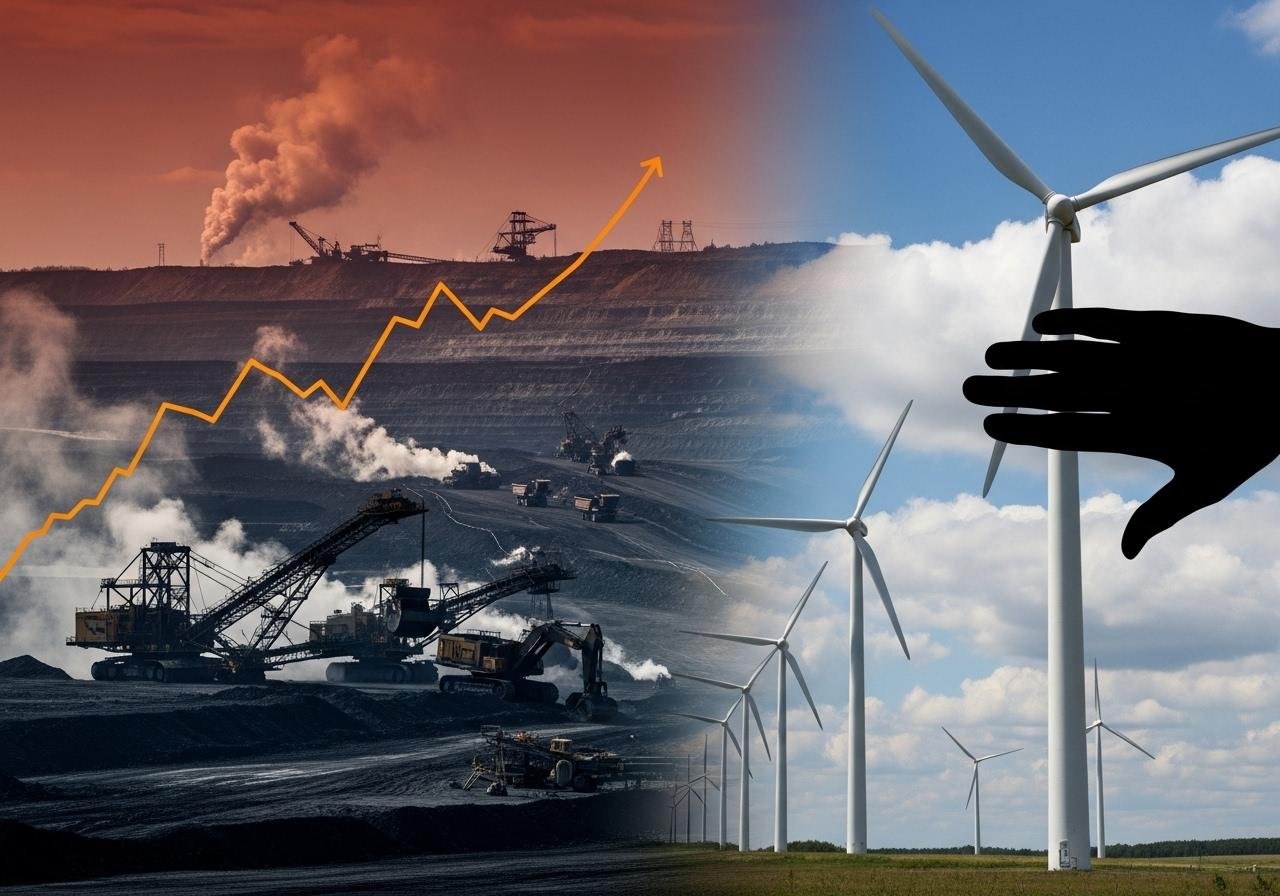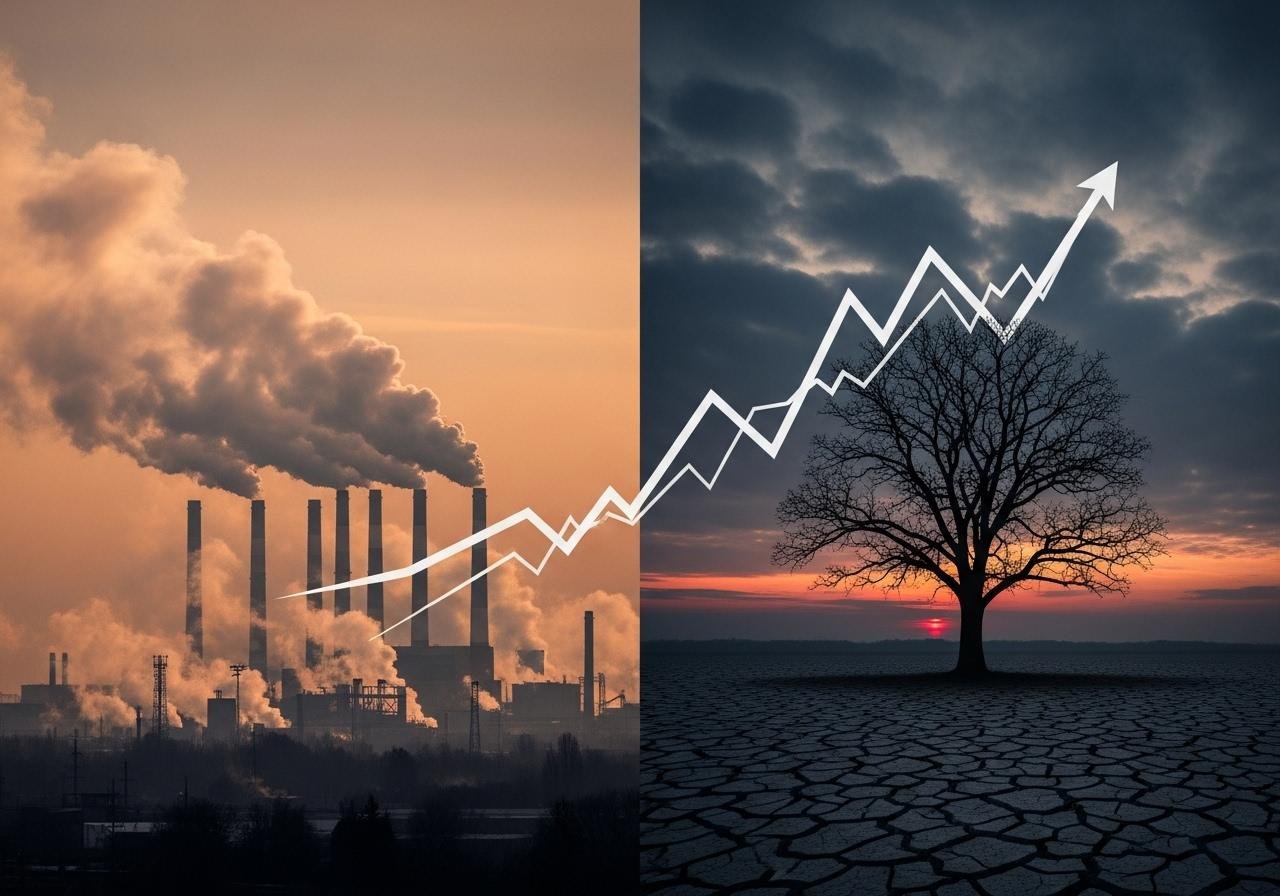
Energy Policy and Fossil Fuel Promotion
When you look out at the globe, you see many countries moving rapidly toward renewable sources of energy, with capacity expected to double worldwide by 2030. While this global “greenification” of energy production is often framed as a political or environmental movement, its true momentum stems from economics: solar and wind power are now among the cheapest forms of energy available, often undercutting coal and gas on price while producing far fewer emissions.
Yet even as the world charts this encouraging trajectory, the second Trump administration has taken deliberate policy actions that threaten to slow, stall, or reverse U.S. contributions to that progress—and by extension, weaken international efforts to combat climate change. One of the most consequential moves was the withdrawal of the United States from the Paris Climate Agreement, a global accord designed to limit warming to 1.5°C. while Trump also pressures nations to delay a carbon tax on shippingThe withdrawal sent a clear signal that the administration prioritized short-term fossil fuel expansion over long-term environmental stability, isolating the U.S. from global climate cooperation and undermining years of diplomatic progress.
By expanding oil and gas leasing on federal lands, subsidizing coal, and reducing oversight of methane emissions, the administration effectively reversed decades of progress toward decarbonization. These choices, framed under the banner of “energy independence” and “economic strength,” instead entrenched the U.S. deeper in carbon-intensive industries at the very moment when global markets—and even American consumers—were moving toward cleaner, cheaper, and more resilient energy systems.
Culling renewables
Domestically, the administration has accelerated the phase-out of key tax credits for wind and solar projects, introduced restrictive guidance that limits eligibility for renewable incentives, suspended or cancelled major grant programs and blocked permitting for renewable development on federal lands and waters.
At the same time, the administration has pulled back from core climate science efforts, gutted institutions by firing thousands of scientists and staff, and repealed regulatory standards that underpin the clean-energy transition.
These actions have triggered the IEA to downward revise its U.S. growth forecast, citing policy uncertainty and regulatory rollback in the U.S. as one of the main reasons for lowering its projection for global renewable capacity growth.
As a result, while the world may still double renewables by 2030, the U.S. may contribute far less than expected—and that shortfall complicates global efforts to stay on the 1.5°C or even 2°C pathways – note that we have actually surpassed the 1.5 threshold for over a year already.
Increased demand for electricity
At the same time, as Artificial Intelligence (AI), data centers, and the electrification of transportation drive unprecedented global demand for clean, reliable power, the Trump administration has chosen a path that doubles down on fossil fuels. Rather than preparing the U.S. grid for a future defined by electric vehicles (EVs), smart infrastructure, and AI-powered industries, federal policy has leaned heavily toward coal, oil, and natural gas, framing them as the backbone of national energy security and economic strength.
In practice, this has meant rolling back renewable incentives, expanding offshore drilling, fast-tracking fossil fuel permits, and delaying clean grid modernization projects that would enable large-scale electrification. These policies ignore the reality that AI development, EV charging networks, and modern manufacturing all depend on massive, stable, and low-carbon electricity supply. Instead of leveraging America’s leadership in innovation to power the next industrial transformation with clean energy, the administration’s actions reinforce an outdated model that ties economic growth to carbon emissions.
Trumps actions damage the US economy
This prioritization of fossil fuels over renewables also undermines America’s energy infrastructure and workforce transformation. The U.S. power grid—already strained by rising electricity demand from EVs, AI data centers, and heat-driven peak loads—urgently needs modernization, smart-grid integration, and expanded transmission capacity and by delaying investment in renewable generation and grid upgrades, the administration risks leaving the nation less resilient, less efficient, and less competitive.
Economists warn that these rollbacks will slow clean-tech innovation and forfeit hundreds of thousands of potential jobs in solar, wind, battery storage, and advanced grid management—industries that are booming in Europe and Asia. (Read about how the UK plans 400,000 new clean energy jobs).
Meanwhile, U.S. workers in fossil-dependent regions face deeper instability as automation and global shifts make coal and oil less viable long-term. Instead of leading the clean energy revolution, current policies are locking American workers into declining industries while allies capture the future’s most dynamic and sustainable economic growth sectors.
Changes to National Monuments and Public Lands Protections
The Trump administration has dramatically reshaped the management of America’s national parks and public lands, shifting priorities from preservation to resource extraction. In both policy and tone, the administration has sought to redefine conservation as a barrier to “energy dominance.” Early executive orders directed the Department of the Interior to review and potentially reduce the size of national monuments established since 1996, echoing earlier actions that gutted protections for Utah’s Bears Ears and Grand Staircase–Escalante monuments and internal documents show new efforts to scale back safeguards for additional monuments across Arizona, New Mexico, and California,
At the same time, the influence of fossil-fuel and mining lobbyists has grown unmistakable. Policies have opened millions of acres of public lands and forests to extraction, weakened environmental reviews under the National Environmental Policy Act (NEPA), and prioritized short-term industrial gains over long-term ecosystem health. Conservationists warn that these actions threaten biodiversity, cultural heritage, and the climate stability these landscapes help maintain. In sum, the administration’s approach represents a profound reversal of America’s conservation legacy—transforming lands once held in trust for all into assets increasingly managed for the few.

The Role of the Environmental Protection Agency (EPA) Under Trump
Budget Cuts and Staff Exodus
Under the Trump administration, the Environmental Protection Agency (EPA) has experienced the deepest structural overhaul in its history. Leadership under Scott Pruitt and later Andrew Wheeler—both long-time allies of the fossil fuel industry—ushered in a wave of budget reductions and staff departures that weakened the agency’s ability to enforce environmental laws. The administration proposed cutting the EPA’s budget by nearly 30%, eliminating programs that monitored air and water pollution, cleaned up toxic waste, and supported renewable energy innovation. Thousands of scientists, inspectors, and technical experts left or were reassigned, leading to a significant decline in both enforcement actions and regulatory oversight. These moves reflected a broader ideological shift toward deregulation, framed as reducing “red tape” but effectively dismantling decades of environmental progress.
Science Suppression and Industry Influence
The Trump-era EPA has also become a battleground over science and transparency with erms like “climate change” being removed from official documents and websites, internal research being restricted, and advisory boards restructured to exclude independent scientists.
In their place, appointees with industry backgrounds gained influence over decision-making. This led to the weakening or repeal of major environmental protections, including the Clean Power Plan, the Waters of the United States Rule, and the Mercury and Air Toxics Standards. Enforcement against polluters fell to the lowest level in 30 years, signaling to industry that noncompliance would go largely unpunished. Former EPA officials and environmental advocates argued that these changes undermined scientific integrity, compromised public trust, and redirected the agency’s focus from health protection to industrial facilitation.
Health and Climate Fallout
While industries have received some short-term regulatory relief, the long-term consequences of these policies are severe. Weakened pollution standards have increased the risks of respiratory illness, cardiovascular disease, and mercury exposure, particularly in low-income and minority communities located near power plants and industrial zones. The rollback of carbon and methane regulations also accelerated greenhouse gas emissions, complicating U.S. commitments to global climate targets. Reversing these policies will require years of administrative work, scientific review, and litigation—delaying climate action when time is most critical. Beyond U.S. borders, the administration’s retreat from environmental leadership has damaged America’s credibility in climate diplomacy and clean-energy investment, ceding ground to Europe and China in the emerging green economy.
Consequences and Long-Term Impacts
In the short term, the administration’s deregulatory push reduced costs for heavy industry and fossil energy producers. Yet the long-term costs—to public health, climate stability, and future economic competitiveness—are mounting. Environmental rollbacks have worsened air quality, increased pollution-linked deaths, and slowed the transition to renewable energy. The erosion of EPA authority has also made it harder for future administrations to rebuild environmental safeguards quickly, as each rescinded rule requires new research, public consultation, and court validation. Globally, these actions weakened U.S. influence in climate negotiations and emboldened other nations to delay their own emissions reductions.
Key Points Section
– Trump’s policy rollbacks affected the Clean Power Plan and fuel economy standards.
– Climate change skepticism led to the U.S. withdrawing from the Paris Agreement.
– The administration favored fossil fuels, impacting renewable energy initiatives.
– Public lands experienced increased resource extraction pressures.
– The EPA saw significant deregulation and budget cuts.

FAQ
Why did the Trump administration roll back environmental regulations?
The Trump administration rolled back numerous environmental protections to ease restrictions on businesses and energy producers. The aim was to stimulate economic growth and job creation by reducing what it viewed as burdensome federal oversight on industries like oil, gas, and coal.
What was the impact of withdrawing from the Paris Agreement?
Leaving the Paris Agreement distanced the U.S. from global climate efforts, weakening international cooperation on reducing greenhouse gas emissions. It also signaled a shift in U.S. climate leadership, creating uncertainty about the country’s long-term commitment to sustainability.
Did renewable energy policies advance during Trump’s presidency?
Renewable energy growth continued mainly due to market trends and state-level initiatives, not federal support. The administration instead focused on expanding fossil fuel production, which slowed national momentum toward clean energy transitions.
How did these policies affect public lands?
The administration reduced the size of several national monuments and opened more federal lands to drilling and mining. These actions drew widespread criticism and legal challenges from environmental groups concerned about threats to ecosystems and cultural heritage sites.
What might be the lasting impact of the Trump era on the environment?
The rollbacks of key regulations could have enduring consequences for air quality, water safety, and wildlife preservation. Reversing these changes and restoring environmental protections may take years, influencing how future administrations approach climate policy.
Summary
– Climate change skepticism affected international and domestic policies.
– Fossil fuel promotion was prioritized over renewable energy.
– Public lands faced increased industrial pressures.
– The EPA’s role and effectiveness were reduced.
Reference: https://en.wikipedia.org/wiki/Domestic_policy_of_the_second_Trump_administration#Climate_and_environment
The post Trump has it in for America and the environment appeared first on Green.org.














